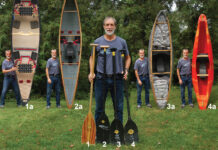The topic of the perfect paddle length is second only to the discussion of the perfect boat whenever more than two paddlers gather. From online forums to campfires, birthdays to wedding receptions, and even at natural disasters—especially floods—nowhere is off limits when it comes to talking about the perfect paddle length.
Recently, I was heading off for a week of teaching tandem canoeing with a mild injury, resulting in very limited range of motion in my shoulder. In desperation, I grabbed my daughter’s paddle, a good three inches shorter than what I usually paddle with.
I was surprised to find how well it worked. Yes, doing a rudder stroke while sitting up on the seat of a big tandem tripping canoe was a bit ineffective, but most of my other strokes weren’t much affected. I came away from the week vowing to try an even shorter paddle in my solo canoe.
Paddle length is influenced by canoe length in that a short canoe responds—or misbehaves—faster than a boat with a longer waterline, which will track more predictably. A shorter paddle equals a quicker stroke rate, therefore reducing delays in corrections.
Paddle 1 is 56 inches—the length I use when sitting on the higher seats of a tandem canoe like this Esquif Pocket Canyon. It’s a paddle I can rely on to maneuver a heavily-laden 17-foot tripping canoe through rapids, serve as a tarp pole or dig a house foundation if the backhoe doesn’t show up.
Paddle 2 is a good length at 55 inches for slalom racing in my 11-foot, eight-inch Spark, which requires digging deep into the eddy pools to catch upstream slalom gates and slicing the paddle through the water for control. Paddle 3 is my playboat length at 54.5 inches. Long enough to dig and drag on shallow slides, but short enough to make offside strokes easy in my short 9’2” L’edge.
Paddle 4 is my daughter’s canoe tripping paddle—54 inches long—but the perfect length for me when I’m in the nine-foot Esquif Extasy. The shorter shaft allows fluid transition between onside and offside strokes. Yes, it’s a little short for a decent rudder stroke, but power steering is the goal, so I shouldn’t be ruddering anyway.
And there you have it—justification for owning more than one paddle. You’re welcome.
Paul Mason teaches Paddle Canada canoe courses and offers technique tips on his Facebook page and at www.canoeinstruction.co.
Quintuplets—how does he do it? It’s tricky. Photo: Paul Mason









Could you do an article which describes the seating/kneeling support you have in your pictured canoes? I am not familiar with such arrangements which I am sure works great . Thank you, Tim Kinkead Williamsburg, Va
Really, a difference of 1-3 inches makes that much of a difference? I find that premise ridiculous on its face. I could see a several inches difference would alter you paddling, but a half inch here or there is absurd. Maybe competitive paddler might appreciate incremental differences, but otherwise this article is not of value to us amateurs.
I agree with John Taylor on this. Such a small difference in paddle length should not be that noticeable. It is likely the differences he thought he noticed were actually from different hull shapes & dimensions of the various boats and his shoulders being at different heights from the water as the seats are different in the various boats.
Agree with John and Greg. This is an article about nothing.
I’m 5’10” tall and paddle almost entirely solo canoe. And I’m kneeling 95% of the time. I’ve used a 50″ bent-shaft paddle for 30 years, even on whitewater up to class 2. When I was 30, I could use a 52″ bent-shaft, but that was long-ago. But I knew another solo canoeist who used a double-bladed kayak paddle after a shoulder injury. He went back to single, bent-shaft paddle after his recovery.
I agree with those guys above, this article was not worth much. But an article about how to persuade Carlisle to bring back their spoon-blade bent-shaft paddle with an aluminum-tube shaft and plastic blades, that would be great. There is no comparable substitute for this little-known paddle, which was never real popular and was always hard to find.